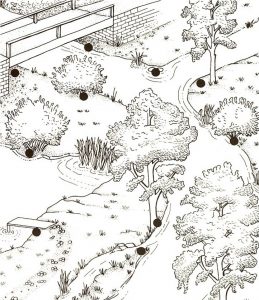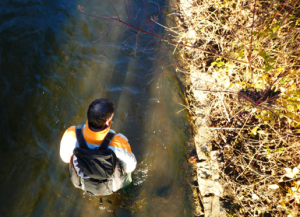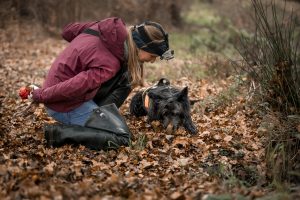Efficient otter survey method

Marking spots of otters along a stream. Claus Reuther
In the last century, the Eurasian otter (Lutra lutra) experienced a massive population decline in Europe, leading to local but also national extinctions. Since some decades, the otter is returning – sometimes slowly, sometimes a bit faster – to areas where it was absent for a long time.
Knowledge on distribution and occurrence is fundamental for the conservation of a species. However, not all species can be observed and counted easily. In freshwater systems, the Eurasian otter is a nocturnal and elusive semi-aquatic mammal. The survey of otters therefore mostly relies on indirect signs suchs as spraints (the name for otter feces) and tracks. Spraints can often be found on conspicuous elements along the water body as shown in the graphic on the right side.
IUCN standard method
For the Eurasian otter, the IUCN standard method for surveys consists of four sites in each cell of a 10 km grid laid over the area to be monitored. A site is a 600 meter stretch along the bankside of a waterbody, mostly running water. This stretch is then examined for spraints and tracks of otters (see Reuther et al., 2000 for further information on the IUCN Standard method). The implementation of a standardised method allows for the comparison of surveys accross areas but also between surveys over time. Such data is crucial to document the global distribution of the species and estimate population trends.

Survey along a river bank. Irene Weinberger
This type of survey is time-consuming, and often spraints are overlooked. Therefore, in some regions of Europe, an abbreviated procedure is used: the survey underneath bridges. Otters like to mark under “cave-like” bridges – a structure that humans can easily identify. Also, the area to be searched is small compared to a 600 m stretch. However, there is still no standardized protocol that defines the number of bridges that must be examined in order to detect otters with a certain probability.
Our project
With this study, we are closing this gap: We aim to identify the number of bridges needed to detect otter presence in a 5 x 5 km grid cell and to develop guidelines for practitioners to decide where transects need to be walked and where they can rely on the so called “bridge monitoring” method. For this, we rely on the sensitive noses of trained wildlife detection dogs in order to be able to estimate detection probability of humans to find spraints. In over 50 cells (5 x 5 km) with known otter presence we will search for spraints thus collecting enough data for a sound statistical analysis.
Support us!
Become a donor for this project! Pro Lutra is a non profit foundation dedicated to the return of the otter in Switzerland. Our work is only possible with the generous help of many people.
Donations can be made as transfer to our Postfinance banc account (please add “Project bridge” as comment) or using the QR-Code either for e-banking or TWINT. For donations via debit card you can also use our donation form at the end of this page.
IBAN: CH07 0900 0000 9070 8358 9
BIC: POFICHBEXXX

Cooperation & Background
In the last years, the foundation Pro Lutra and Artenspürhunde Schweiz have carried out in-depth studies on the use of wildlife detection dogs for otter spraint detection. Using this knowledge, it is possible to address important questions regarding to otter ecology and the best practice for otter survey including the standardisation of the “bridge monitoring”-method and to develop specific guidelines for using detection dogs to survey otters in the most efficient way.

Inola and her handler are ready to dive into this project. Thank you for your support!



